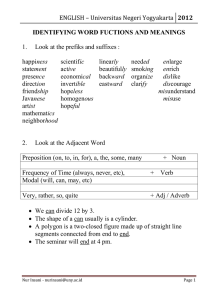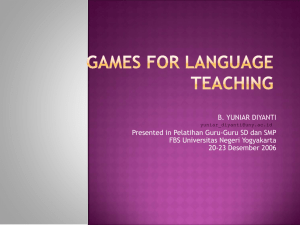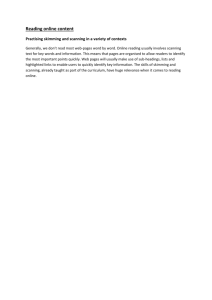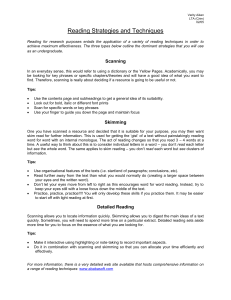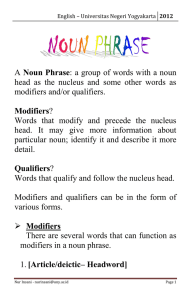READING STRATEGIES: 2012
advertisement
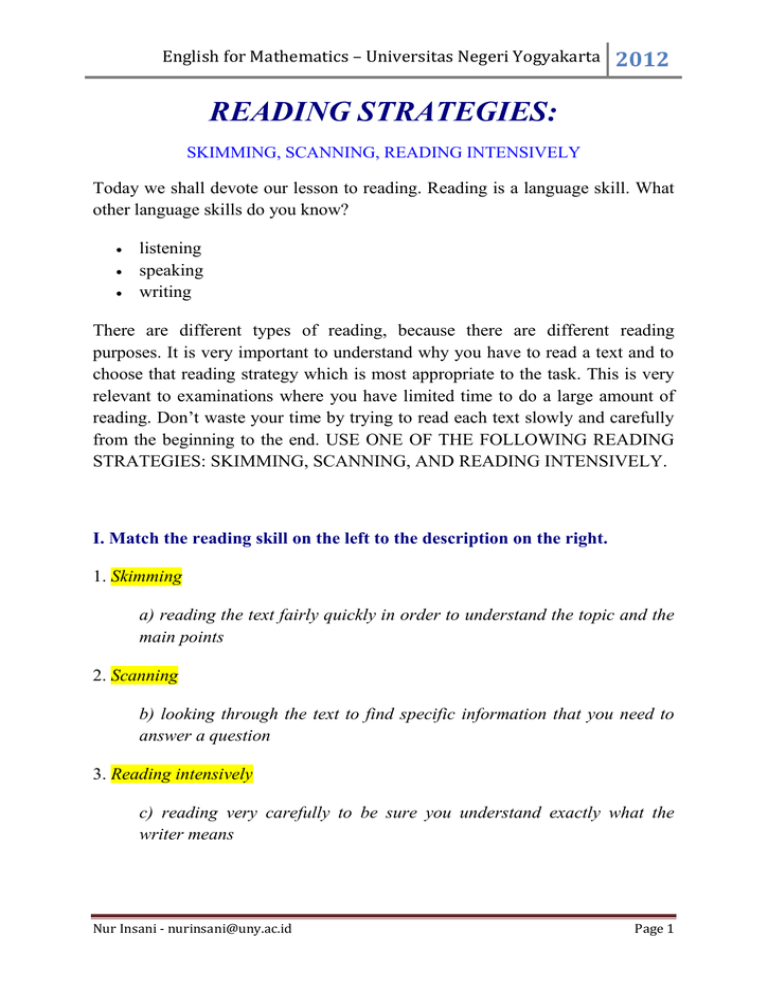
English for Mathematics – Universitas Negeri Yogyakarta 2012 READING STRATEGIES: SKIMMING, SCANNING, READING INTENSIVELY Today we shall devote our lesson to reading. Reading is a language skill. What other language skills do you know? listening speaking writing There are different types of reading, because there are different reading purposes. It is very important to understand why you have to read a text and to choose that reading strategy which is most appropriate to the task. This is very relevant to examinations where you have limited time to do a large amount of reading. Don’t waste your time by trying to read each text slowly and carefully from the beginning to the end. USE ONE OF THE FOLLOWING READING STRATEGIES: SKIMMING, SCANNING, AND READING INTENSIVELY. I. Match the reading skill on the left to the description on the right. 1. Skimming a) reading the text fairly quickly in order to understand the topic and the main points 2. Scanning b) looking through the text to find specific information that you need to answer a question 3. Reading intensively c) reading very carefully to be sure you understand exactly what the writer means Nur Insani - nurinsani@uny.ac.id Page 1 English for Mathematics – Universitas Negeri Yogyakarta 2012 II. Which skill should you use when you: a) read the instructions and questions? ________ b) read the text for the first time? ________ с) need particular facts or figures from the text? ________ d) are choosing the right answer to a multiple choice question? ________ What we do after we skim through the text? Usually we will be interested in certain specific details. So, we look for details. We look at numbers, names, formulae, amounts, etc. This kind of reading activity is called scanning. Scanning is reading a text, also very fast, to find important spots in the reading. It is like what the computer does when it scans a virus. The computer will scans through the data or program files to see if there is a virus. Nur Insani - nurinsani@uny.ac.id Page 2 English for Mathematics – Universitas Negeri Yogyakarta 2012 Scanning is a reading skill used to locate key or specific information quickly, eg dates, numbers, examples & definitions. It is a technique you often use when looking up a word in the telephone book or dictionary. You search for key words or ideas. In most cases, you know what you're looking for, so you're concentrating on finding a particular answer. Scanning involves moving your eyes quickly down the page seeking specific words and phrases. Scanning is also used when you first find a resource to determine whether it will answer your questions. Once you've scanned the document, you might go back and skim it. Why scan? To pick up on detail. To fill in gaps in your knowledge (give depth). Examples of Scanning The "What's on TV" section of your newspaper. A train / airplane schedule A conference guide Nur Insani - nurinsani@uny.ac.id Page 3 English for Mathematics – Universitas Negeri Yogyakarta 2012 Steps for scanning Look for key words, or words that are repeated. Look for definitions. Look for highlighted words, eg words in bold or italic. Look for numbers, eg dates and statistics. Look for examples, including diagrams. Activity Scan the following text and answer each question. Pay attention to the introduction - identifying the main points to be covered, the headings & topic sentences and the conclusion. Scan for keywords and numbers. You have a time limit of 60 seconds for each question. Activity 1.docx 1. What percentage of information is forgotten in short term memory if it is not transferred to long term memory? 24% 50-75% 100% 2. How many pieces of information can be remembered at any one time? 5-7% 50-75% 57% 3. What is the definition of schema? a. Thousands of individual parts b. Long term memory c. Associated pieces of information 4. Find an example on ho schemas overlap? a. Main points- sub points b. Interconnectivedness – individual Nur Insani - nurinsani@uny.ac.id Page 4 English for Mathematics – Universitas Negeri Yogyakarta 2012 c. Government – politics 5. Identify a way that chuncking information is achieved. a. Main points- sub points b. Interconnectivedness – individual c. 5-7 bits of information 6. Automating: memorizing, mnemonics, and visual images are all part of which section? a. Chucking b. Other memory techniques c. Long and short term memory Nur Insani - nurinsani@uny.ac.id Page 5
